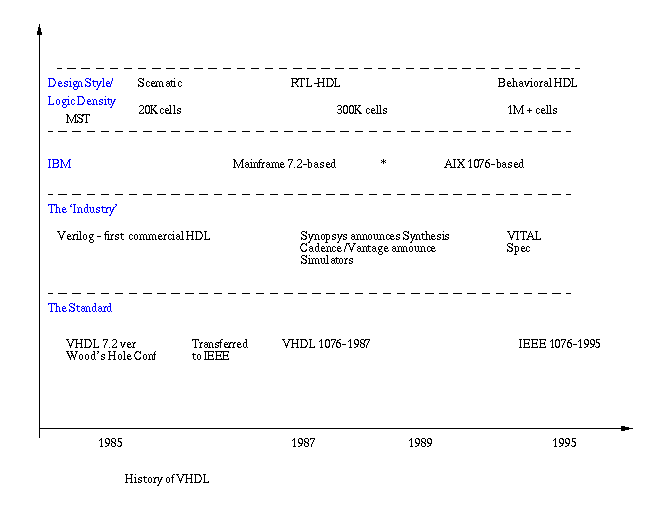EE295 - ASIC Design Using VHDL
Introduction
Assignment: Read Ch 1
We discuss the VHDL Hardware Description Language Introducing
a Few Key Constructs. We discuss the ASIC Design Process.
Outline
- What is VHDL?
- History of VHDL
- Useful VHDL Resources - My 'Top Ten' HotList
- What is an ASIC?
- Basic VHDL Lexicon
-
-
-
-
What is VHDL?
- VHDL = VHSIC Hardware Description Language
- VHSIC = Very High Speed Integrated Circuit
- Combines Elements of Programming and Traditional Hardware Design
- Supports Complex Hierarchical Design with:
- Strict Rules of Scoping
- Strict Type Enforcement
- Design Library Integrity
- Very Rich and Expressive:
- Technology Independence
-
-
-
History of VHDL

- DoD interest in Successful System Integration
in an Environment of Independent Contractors using
Diverse Design Tools and Methodologies.
- 'Wood's Hole Conference', A Brain Trust, Best Minds of IBM
TI, Intergragh, Consultants. Mission: Define A Super HDL. Result: VHDL7.2.
- Thrived in IBM AS/400, Many Other IBM Designs, Delighted DoD
- Stalled in Marketplace/Academia
- Move VHDL into IEEE ( ~= Public_Domain ). Additional Review
& Refinements. Result: VHDL-1076
- Currently about 8 sub-groups in
- Groups of Research & Development, CAD Vendors, Technology Providers
Conferring on Implementation Details.
- Used Extensively in Design Automation Development, Research
-
-
-
-
What is an ASIC?
- ASIC = Application Specific Integrated Circuit
- Implements Custom Function According to Description, not Off-The-Shelf
- Described in an HDL ( VERILOG, VHDL ) In an Abstract Technology
-Independent Fashion.
- Verified Using a Simulator Product - Analogous to Software Debugger
- Constructed Out of Logical Function Cells ( AND, OR ) and Re-Usable
Macro Building Blocks (ADDERs, REGISTERS )
- 'Mapped' or Translated Using a Synthesis Product
- Implemented in Either Field Programmable, Standard Cell or Gate Array
Logic Families.
- Connected to External World Through Standardized Protocols and
Electrical Interfaces.
- Hard Cold Facts:
- Competitive Environment. Entrepreneurial.
- Short Time to Market.
- Short Successful Product Life Cycle.
- Typical Uses:
- Glue logic to connect uProc to external devices: disk drives, CDROM
- Consumer Electronics: Cellular Phones, Games
- Entity - Architecture
- Component Declaration and instantiation
- Defines another design object
- analogous to a 'socket'
- May Represent Objects ( Entities/Architectures ) But !!
- Not Implicitly Bound to Entity of Same Name
- Package - Library - Use
- Package
- 'Containerizes' Reusable Design Objects. Declarations of:
- Components
- Functions
- Constants
- Signals
- Borrowed From The 'C' Programming Model
- Divided into a header ( ~= .h file ) and body that can
be seperately analyzed. The Interface Can Be 'Visible' While 'Hiding'
The 'Implementation'.
- Traditional Mechanism for:
- ASIC Foundries to Deliver Library Support
- CAD Vendors to Provide Tool Support
- Designers to Provide Re-usable Macros
- Library - the Repository that you Analyze VHDL into or Access to
Resolve Package References. The Library Statement Declares Your Dependence
on a Library for the Design Object that Follows.
- Use - Together with the accompanying library statement specifies
the exact design object, package, library combination using ordinary
scoping rules.
**NOTE
- VHDL Enforces Library Integrity.
- Any Updates to Libraries You Depend On Require You to Re-Analyze
- The Infamous Time/Date Stamp Mismatch Error Message.
- Process
- Actually a Concurrent Statement! Appears in the Body of an Architecture.
- Delimits a Section of Sequential Code
- Optional Sensitivity List Indicates Which Signals 'Wake Up' a Process
- Self-Contained Declarative Region
- Important Time Does Not Increment in a Process - Not Even Delta
Time!! Signal Assignments Don't 'Take Place' Until The Process Suspends.
How was the class? Send your comments to jswift@vnet.ibm.com
Return to Class Home Page
Copyright 1995, James Swift
Copying this document without the permission of the author is prohibited
and a violation of international copyright laws.
